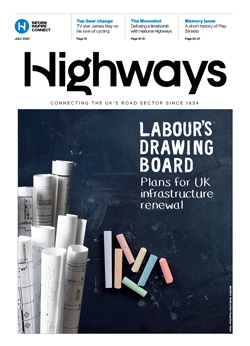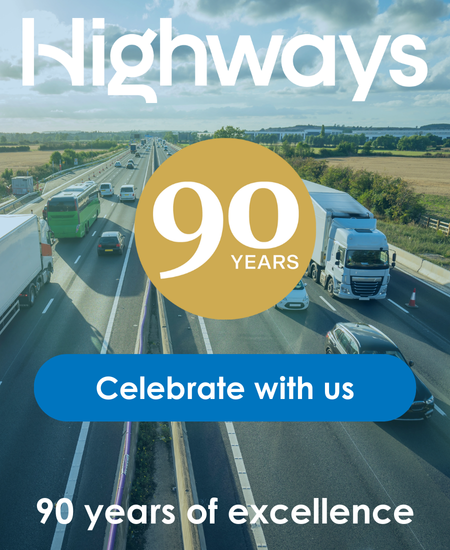Traffic Group Signals (TGS) is a new division of the Traffic Group, and will be unveiled at Traffex 2019 on 2-4 April at the NEC, Birmingham. In advance of the big launch, Highways caught up with Danny Thorn, its head of commercial, to talk business.
The Traffic Group has a portfolio of leading businesses focused on product solutions designed to help create safer, greener and more efficient traffic and transport environments. The brands that will sit under its new Traffic Group Signals banner are Hollco, Pike Signals, Arkon (incorporating FleetAssist) and Safelite.

What is it like keeping track of such a wide range of brands with different identities?
While the brands are all unique, cover specific requirements and are well-established, there are natural synergies between the technology used within Traffic Group Signals and the wider Traffic Group companies. We have specific business units for each brand for manufacturing that work closely with the centralised functions to ensure we maintain brand uniqueness while benefitting from the combined expertise of the group.
Do you have sister brands or twin brands that are more likely to work together or do the synergies happen naturally?
TGS has been formed to enhance the natural synergies that exist between the four brands. Hollco and Pike Signals provide a wide range of portable and temporary signal products, from basic two-way traffic signals to Pike’s comprehensive traffic and pedestrian layouts spanning up to 34 heads.
Arkon sits alongside Hollco and Pike to provide repair and maintenance and Fleet Assist support to clients, many of which have both brands' products and services. Finally, Safelite uses the same technology as portable signals for off-road locations such as race tracks and warehouses. All the brands and technologies are closely linked.
How are you adapting to the potential new world of traffic signals through the Internet of Things and apps for instance?
Portable traffic signals have already undergone a number of major transformations during their history: the shift from cable-linked sets to radio based units; from halogen bulbs to LED; from diesel generators to deep-cycle AGM batteries for instance. The next transformation is based around improved detection capacities, improved connectivity and data sharing, and intelligent decision-making.
We are actively working on a range of developments in these areas. Some of these are available right now, like our ARVA and AutoGreen technology, and some we are busy with but you’ll need to wait just a little longer to find out about.
Throughout our organisation we are passionate about the opportunities that this new technology brings and are working hard to develop the right products at the right time. Because the art of the possible has grown so much, it is more important than ever to understand the needs of our customers. Only when we understand this can we get the products right.
Our ARVA and AutoGreen technology is a great example. We identified that traffic management companies were being asked to deploy a large number of jobs under manual control. This caused significant challenges for them to deliver, exposed workers to pollution and abuse for long periods and could not actually be proven to achieve the traffic flow benefits that were hoped for. By employing the technology as a tool to solve a customer problem that we ensured we understood in depth, we know we are not developing technology for its own sake; it will actually make a difference. Taking time to understand the problem in real depth is the key.
How has the relationship with your customers changed in the last five years and how has your relationship with the drivers changed?
We think more now about driver satisfaction than we have ever done previously. The relationship between drivers and temporary traffic management is notoriously challenging. Waiting at a set of temporary lights, in a location where you would normally drive straight through, is frustrating for all of us. For years, the industry struggled to identify what could be done about driver frustration for some scenarios such as two-way shuttle sites.
Over the last two years we have expended significant effort to understand and respond to the causes of frustration that are present at these sites. Frustrations include lights that are set with inappropriate times, or which don’t give each phase a ‘fair’ turn. Drivers shown green signals when vehicles are still exiting the works are a problem and drivers passing through the lights at red pose their own risks and issues. Also, importantly, manually operated lights are very variable in their operation for a whole host of reasons.
During our development of ARVA and AutoGreen we identified that a lot can be done to alleviate these causes of frustration. Following on from extensive observation of the problems experienced by traditional VA-based systems, we targeted a wide range of measures aimed equally at both reducing driver frustration and improving efficiency of operation.
We have spent the last year trialling the new technology at a wide range of sites across the country, observing signals for long periods while also analysing journey times through the site using ANPR cameras.
Customer relationships have evolved in this time also. Historically, portable signals were seen as an item of plant to be hired offering limited functionality. Now we work closely with proactive traffic management contractors, who have extensive fleets of purchased signals, and local authorities to identify the needs of the networks. Portable signals are seen as an essential part of temporary road work and traffic management planning, and are receiving much more attention regarding their deployment and operation. Ultimately, the demands being placed on our customers are increasing constantly and this requires us to help them respond.
What are the big trends in traffic signals?
The job of portable and temporary traffic signalling is becoming increasingly important. The number of sites that are deemed to be highly sensitive or that require special planning increases year-on-year. Traffic management companies are called upon to minimise impact on the network and require a new generation of equipment in order to achieve this.
Another trend is a greater emphasis on products that are precision-designed for security and convenience that just make them easier and better to use.
The Hollco RC2 is a great example of this. Simple things can matter, like having eye-level controls, well-designed tie-down points and ergonomic battery swap-outs. We’ve carefully engineered a tripod for the product that works better than anything we’ve produced for this purpose previously. There are also some big wins, like 18-day battery life, cable-free linking and high quality chargers built into the unit. The trend here is the desire for higher performance equipment that allows traffic management companies to deliver more jobs and with lower running costs.
We heard recently about the possibility of artificial intelligence (AI) in traffic signals so lights start to optimise the best phases on their own. What is your take on this?
Increased use of AI is one of the key mechanisms through which we can bridge the gap between growing traffic levels and a relatively fixed road network capacity. Permanent traffic signals have for many years benefited from having a lot of effort spent on ensuring that they operate in the most efficient manner possible. This expectation of optimum efficiency is now being applied to portable and temporary signals. The challenge is different of course. How do you ensure that signals that are often only deployed for a day will operate with high efficiency? The level of analysis and pre-planning that goes into the setup of permanent signals would not be economic to apply.
The answer is to apply increasing levels of automation and intelligence, and to make sure that the vehicle detection data we base our decisions on is the best possible. TGS is uniquely placed to develop this type of technology, having access to a broad range of specialist software, electronic, radar and mechanical engineers within our ‘Traffic Group Technology’ R&D function. Specially developed detection products from AGD Systems and MAV are a great basis on which to develop new traffic products. The AGD 302 radar, for example, is the first ever FMCW technology radar applied to portable signals and was developed specifically for use in the Hollco RC2 and Pike ARVA product ranges.
Technology does need to be carefully applied of course. Ill-conceived attempts at ‘smart’ technology can backfire, for example simply increasing green time without intelligent controls often leads to standing traffic. We test and trial new technology extensively to understand and prove its real-world performance and suitability for operation across the very wide range of conditions it will experience.
Urban traffic control (UTC) is coming under more and more pressure with congestion in cities these days. From your perspective seeing it in different places what are the strategies that work? And what is the help that local authorities need the most?
UTC is not yet routinely used in portable or temporary signals. This is for many reasons but mainly owing to the way temporary traffic management is funded and the availability of low-cost, low-power technology.
The deployment of UTC-capable equipment on a temporary basis requires a good level of collaboration between utilities companies and highways authorities. Permits to work could be used as a catalyst to aid this collaboration and to drive other broader improvements. A wide range of impacts caused by roadworks can often be mitigated through a co-operative approach including journey times, pollution levels and safety. Sometimes the overall duration of the works can also be improved upon.
Technology can really help in this area and although UTC can be one part of the solution, the best answer is usually a semi-complex combination of different elements from all the stakeholders involved. Lastly, informing the motorists and pedestrians is key to their understanding on what improvements are made, as all signalled temporary traffic management is usually lumped together under a big inconvenience label.





